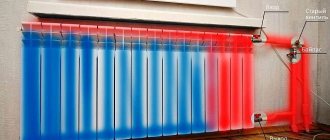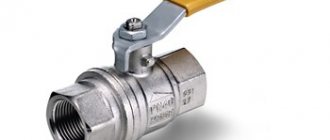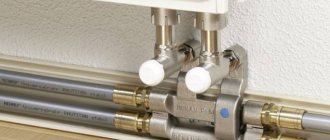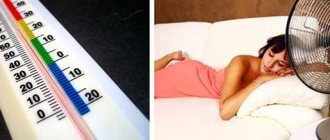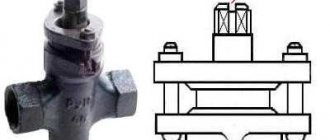What are the reasons for radiators not fully warming up?
- The last radiator in the heating system does not heat up - the reason is insufficient power of the circulation pump, non-observance of angles and slopes when installing the pipeline.
- The lower part of the heating radiator does not warm up completely - this problem is usually typical for aluminum heating radiators. In some cases, the cause is an incorrectly set mode of the thermostat installed on the coolant supply to the battery.
How to eliminate uneven heat transfer
Not all problems can be solved on your own. Poor heat transfer from the radiator may be a consequence of non-compliance with the slopes, indicating gross violations in the installation of the heating system. In this case, you will have to invite a specialist in heating systems.
Some heating problems can be fixed on your own.
- Air locks - air in the heating system is an inevitable consequence of filling pipes and radiators with coolant. A characteristic sign of the problem is that the radiator is warm at the bottom and cold at the top. If the section heats up unevenly, you can try to bleed air from the system using the Mayevsky valve. Some owners initially install an automatic air release valve.
The heating battery is half cold, what should I do?
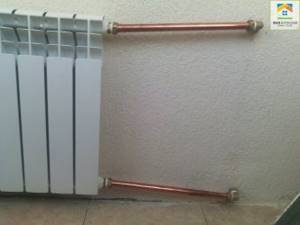
Initial data: Five-story Khrushchev building, 4th floor, single-pipe heating system, coolant supply from below. Replacement of all cast iron batteries with bimetallic radiators Global Style Plus 500. In winter, I felt that it was cold in the apartment. It is not the entire radiator that heats, but the first 2-3 sections (10 sections in total). Why.
Answer: Insufficient pressure (pressure) in the heating system. In short, the coolant flow does not push through the entire radiator; it moves along the path of least resistance through the first sections. The radiator in the kitchen (4 sections) does its job well.
Decision: The decision was made by competent plumbers at the stage of repair and replacement of pipes and radiators. On the heating riser between the inlet and outlet of the coolant there was an adjustment valve. I didn't know about him, because...
it was hidden in a decorative partition, and the finishers forgot to make a technological hatch there. By changing the flow area of the riser pipe, we create hydraulic resistance and force the liquid to move in the direction we need, i.e.
through all sections of our 10-section bimetallic radiator. I pressed it right away, the radiator became all hot after 3-5 minutes.
Often, residents of both apartment buildings and private houses are faced with the problem of cold radiators. In this article we will explain why this problem occurs and what to do if the batteries are cold.
Why do the batteries in the apartment not warm up well?
Reason 1: air locks
Often the radiators in the apartment are cold or not warm enough due to air locks. As a rule, this problem is relevant for residents of upper floors, since the air tends upward through the pipes. In order to eliminate air jams, a Mayevsky crane is used. It allows you to release the collected air and ensure full circulation of the coolant in the pipes.
Reason 2: non-optimal connection of heating batteries
The first sign of an incorrect connection is uneven heating of the battery. The radiator will not heat up enough if the water supply comes from below. In this case, it is best to change the connection diagram from the side or bottom to diagonal.
Reason 3: a large number of radiator sections
Uneven and weak heating of the radiator may be the result of too many sections. It is better not to allow the battery to be installed in more than 12 sections.
Reason 4: low coolant temperature
Sometimes batteries remain cold in winter due to the low temperature of the coolant itself (water). In this case, you must contact the house management.
Why do batteries in a private house not warm up well?
Just as in the case of a high-rise building, there may be several reasons for the poor performance of heating batteries in a private house.
Reasons for the battery not heating up
Air locks are the main reason for insufficient or uneven heating of radiators, but there are other reasons for this unpleasant phenomenon. These include :
- Poor circulation of coolant through the system pipes.
- Incorrect battery connection (for example, when the supply is connected to the bottom hole and the return to the top).
- Clogged inside the pipes and the battery itself.
Let's consider each possible option in more detail.
Insufficient water pressure in the system
As you know, all heating systems are divided into two main types: gravity (gravity) and forced. In the latter case, a water pump is installed, which drives the coolant through the pipes, thereby ensuring uniform heating of the radiators throughout the house.
In the gravitational scheme, movement is achieved due to the difference in density of cold and hot water. In this case, the boiler should be installed at the lowest point, and the expansion tank at the top. This option for installing a heating system can answer the question of why one battery is hot and the other is cold. The thing is that hot water warms up radiators located in close proximity to the boiler, while those located far from it lack coolant movement and do not heat up.
The solution in this case would be to install a circulation pump, which will provide additional acceleration to the hot water moving through the pipes. It is better to perform the installation through a bypass; this will allow, in the event of a breakdown, to remove the device without draining the system and stopping the heating.
Why are the batteries cold?

You recently made repairs in your house or apartment, but the radiator at the bottom is cold and hot at the top. Perhaps only the first sections work correctly? Is the overall efficiency of the heating system insufficient even though the radiators are new? All these problems can be faced by both residents of elite penthouses and “mere mortals” living in standard apartments.
It’s good if problems with batteries arose in the fall, when the temperature of the “outside” air is not yet too low and there is time to carry out repairs as planned. But, alas, this is not always the case. Other “lucky ones” receive a completely cold radiator with a hot riser right in the February frosts or even on New Year’s Eve, which is why they spend the next few days in an exciting quest “catch the municipal plumber.”
But the biggest problem is not even the suddenness of the onset of symptoms, but the absence of clearly visible causes. Because of this, the answer to the question of why the heating radiators in the apartment do not heat up has to be found almost empirically. It is impossible to reduce the risk of being left without heat (although for old cast iron radiators it is many times higher), but it is still possible to understand the main factors that contribute to the transformation of your apartment or house into a branch of a polar station.
Let's understand the basics
Most often, problems with heating (provided that it has not been turned off for non-payment) are of two types. The first is the uneven heating of the radiators (the bottom is cold, the top is warm, the pipes closest to the inlet work as expected, the ones further away do not heat at all). The second – the most “popular” – is indicated by the formula “the riser is hot, the battery itself is cold.”
Most often, the reaction of residents to a drop in room temperature to 10-12 degrees Celsius can be described in one word: panic. It seems to them that the problem cannot be solved without replacing all the radiators, and since most often there is no money for such an enterprise, the prospect of going to the bank for a loan becomes quite real.
Meanwhile, in most cases, such a scenario can be avoided. In other words, if the heating radiator does not heat, this is not always a death to your budget. It will not be possible to completely avoid expenses, but it is not at all a fact that they will necessarily turn out to be excessive.
The most common causes of cold batteries
- The battery is too close to the wall or floor.
- Incorrectly selected radiator (all complaints go to builders or repairmen).
- Small bore valves.
- Pipes or polypropylene (this material tends to let air into the system).
- Errors when connecting the radiator.
- The pipe does not have a free flow due to melting at the joints.
- The system was not balanced after installation.
- Incorrect wiring.
The last option is the most difficult in terms of upcoming expenses. If the batteries only heat up at half capacity, then you can wait a little longer for repairs. But if the temperature in the room barely exceeds 10 degrees, you cannot delay calling a technician. Incorrect wiring is relatively rare, so the chance of “winning a lucky ticket” is still very small. It is also worth understanding that there are actually many more true causes of heating problems. But they rather fall into the “unlucky, unlucky” category.
As for methods of eliminating the problem, it is impossible to give unambiguous and effective recipes for all occasions. Much will depend on the actual condition of a particular radiator, the general configuration of the heating system in a house or apartment, the “freshness” of repairs and even the integrity of ceilings/walls (they can “siphon” so much that a battery operating in normal mode will seem faulty).
But in any case, I would like to remind you: if the batteries do not heat well, you need to seek help from an experienced plumber, and not try to deal with the problem yourself. If you still intend to take a risk, estimate how much it will cost to repair your neighbors’ apartment, which may well be subject to flooding.
Uneven heating
This problem occurs with both older Soviet and modern bimetallic radiators. There are about six main reasons why your battery is “partially hot,” but only a qualified plumber can make a correct “diagnosis” after a personal examination of the “patient.” We especially note that each case is individual, so the data given below should not be taken as the ultimate truth.
Radiator clogged
The most likely answer to the question why the lower battery does not heat up. Treatment - cleaning the radiator from the inside - will not require large financial expenses, but you will still have to spend money on calling a plumber.
Reasons for uneven heating:
- Low quality coolant.
The water (especially at the beginning of the heating season) may contain foreign solid particles, lumps of earth, traces of oil products and other debris. - There is air in the circuit.
The culprit of the problem is anaerobic bacteria, the waste products of which settle on the walls of the radiator.
Shut-off valves
Its main task is to regulate the movement of fluid, including its complete blocking. But if any of the component components of the system (note, it can be one- or two-pipe) becomes unusable, the normal coolant flow is disrupted.
The mechanisms that break down most often:
- Sealing washer.
- Ball valve.
- Tap.
- Damper.
The cause of the problem may be improper installation of the device, but most often it is to blame for simple mechanical wear (especially if you installed a Chinese faucet of dubious quality on the battery.
Consequently, if the last battery does not heat due to a breakdown of the shut-off valves, you will have to call a plumber. He will need to shut off the riser, and you will need to spend money on a new tap. But large losses of time and money can most likely be avoided.
Insufficient pressure in the circuit
It is impossible to determine this without special equipment, so you should not make a verdict without instrumental research. You will need the services of a plumber, but in some cases you can cope with the problem on your own.
Main reasons:
- "Tricks" of utility workers. If there is a coolant leak somewhere in the line, the pressure decreases, causing the temperature in the circuit to drop sharply.
- Unsuitable batteries. You will be surprised, but often the cause of trouble can be a modern bimetallic radiator. The fact is that for normal operation it requires increased pressure, which the old communications, designed for cast iron batteries, are simply not able to provide.
- Unsuitable neighbors. The leak occurs due to the fact that someone illegally installed a heated floor system and powered it from the general circuit (this is strictly prohibited).
- The circuit operates with a battery equipped with a bypass with a tap.
- Retrofitting the existing radiator with several more sections.
Methods for resolving the problem will depend on whether you can find the correct answer to the question of why the batteries do not heat well. If it turns out that low pressure is to blame, get ready to communicate with utility workers, talk in a raised voice with your neighbors, or, in the worst case, go to the store for a new radiator.
Clogged heating system
Rust, salt deposits and other contaminants can significantly reduce the diameter of the holes for the passage of coolant or completely close them. The problem causes the home owner to bleed the air, but the battery is still cold. The solution is cleaning with water under pressure or a special solution.
Deposits in the pipe
If shut-off valves are installed in front of the radiator, then the procedure can be completed even during the heating season . First, the coolant supply is shut off, then the connecting elements are unscrewed. In a private house, it is more convenient to take the battery outside and clean it there. In an apartment, they are usually placed in the bathroom, having previously protected the enamel of the bathtub from scratches and chips.
Pneumatic radiator flushing device
Water is supplied to the battery from a pneumatic device, and for best effect it must be hot. To remove rust and deposits, tap the radiator. In particularly advanced cases, a special mixture is poured in, which acts on the deposits for several hours, then is washed off.
With open access to the entire heating system, cleaning can be done without removing the radiators. The equipment is connected to the return hole, and a hose is installed at the other end of the system to remove contaminants. The procedure continues until clean water begins to flow freely from the pipes. Reviews from some homeowners indicate that washing does not always have a positive effect for a long time. Sometimes it’s easier to replace old radiators with new ones than to clean the entire system every 1-2 years. This is especially true for cast iron batteries, which are more susceptible to corrosion inside than others.
The information presented allows you to understand what to do if you bleed the air and the batteries are cold. First of all, you need to make sure there is sufficient pressure in the pipes, otherwise the coolant will not circulate through the radiators furthest from the boiler. If poor heating is observed constantly, the radiators may be connected incorrectly to the system. However, the most common reason in this case is contamination of pipes and batteries, which requires cleaning using special equipment.
What to do when the water supply riser is hot and the battery itself is cold?

Alas, the weather in the house does not depend only on our mood. The creation of the necessary, comfortable microclimate is ensured by heating radiators, that is, batteries. A stream of hot water passes inside them, which heats the device, thereby providing heat flow in the rooms. Unfortunately, apartment owners do not check the sewer riser as often as they should. In a panic that the heating riser is hot and the radiators themselves are completely cold, we begin to take certain actions. Often without giving any results.
So, first you need to stop panicking and seriously start solving the problem. The heating season has begun, you will have to pay for heat, even if it did not reach your apartment for one reason or another. In order not to pay for cold radiators, you need to check the water supply risers, check how the sewer system functions, make sure that heating has actually started in your apartment building, and only you have some problems with it.
Actually, the primary task is to understand the reasons. They will help you understand why the water supply risers are hot and the battery itself is cold. From here it will be possible to move further towards solving the problem that has arisen. Some situations even provide for a scenario in which radiators will have to be replaced. But, let’s hope it doesn’t come to that, and the issue can be resolved using simpler and less drastic methods.
Causes
One of the reasons for insufficient heating of the battery is pipe corrosion
In fact, the sewer riser is a finicky thing. Therefore, there may be several reasons why the water supply risers are hot, although the radiator itself is cold. Let's look at the most common ones.
- The water supply valves are out of order or simply blocked in the basement. Through this valve, water flows through the main line to the apartments. Therefore, since it is blocked there, it means that heat is not flowing.
- There is an option in which the pipe was damaged during the process of welding the riser to the main line.
- It also happens that when installing the heating system riser, the technician left some foreign object in the pipe. Rags, mittens, and sometimes even stones and animals were often pulled out from there.
- An option with incorrect installation of heating pipes in other rooms, in the kitchen, due to which water does not enter the radiator, but passes by.
- A small amount of coolant, that is, water, can pass through the water supply risers. This situation may concern the entire house or a separate entrance.
- It is possible that the water supply risers, like the entire heating system, were simply adjusted and configured incorrectly, which is why the required amount of water does not flow to the heating radiators in the apartment building.
Fixing problems
Diagram of water supply to batteries
Repairing a sewer riser yourself is quite problematic. Especially if you don’t know anything about this kind of work. In addition, if any malfunctions are detected, you should immediately contact the relevant organizations. That is, to those who are responsible for your home, or directly to the organization that is responsible for heating.
If they tell you that they know nothing, the reasons are incomprehensible to them, then you have the right to express everything you think about them. Remember, they are obliged to resolve such issues at the request of the client. After all, it turns out that the heating season begins, you supposedly receive your heat (although for one reason or another it does not reach the water supply risers), and therefore a corresponding debt for utilities accumulates. In other words, although there is no heat, you have to pay for it.
Signs and causes of poor heating performance
| Characteristic signs | Possible reasons |
| The riser is cold | Technical faults outside the apartment |
| The riser is hot, the batteries are cold | Valves are closed, heating system is clogged |
| Cold bottom of radiator | Valves are not open enough, radiators are clogged, low coolant pressure in pipes |
| Cold top of batteries | Airlock |
| The last radiator in the system is cold | System not adjusted, insufficient pressure |
| The part of the radiator farthest from the connection pipes is cold | Insufficient pressure, clogged battery, air lock |
An analysis of the events preceding their occurrence will help identify the causes of malfunctions.
| Work carried out, operating features | Possible faults |
| Replacement of heating devices, pipes | Air lock due to air entering the system or changes in pipe slopes. Clogged pipes and radiators. Reduced flow areas due to errors during system assembly |
| The heating system works without maintenance for many years | Scale has formed, the heat transfer of the batteries has deteriorated, and parts of the shut-off valves have become “stuck” |
| Start of the heating season | The boiler room did not reach its design capacity, employees of the relevant services forgot to open the valves, and air pockets formed when the system was filling. |
| Neighbors were doing renovations | Reduced pressure in the system due to unprofessional actions of neighbors |
First of all, if the heating is poor, interview the residents of the house. If they have the same problem, it means that the boiler room is not working well or the valves in the basement of the house are closed. In these cases, you should jointly contact the management company. If only one apartment is cold, check that the valves are open and there are no air pockets. Call a specialist through the dispatcher of the organization serving the house.
The main reasons for cooling radiators
So, everything is fine with the neighbors, the riser in the apartment is hotter than the cooled battery. This means the problem is local, it's all in the radiator. An excursion into the basics of heat supply convincingly showed that the main reasons why the last battery does not heat and makes the freezing owner so sad will probably be:
- Clogged radiator sections. Due to scale, rust, mineral salts and other impurities settling on the walls of the radiator, the flow area for hot water in the battery is sharply narrowed, the radiator becomes almost impassable for the coolant. Multilayer contamination of the radiator walls has a low heat transfer coefficient, which negatively affects the transfer of heat from the battery to the air in the apartment.
- Single pipe heating system. As discussed above, the batteries of this system are doomed to a kind of thermal injustice: distant batteries do not heat up.
- Incorrect connection. Only part of the battery heats up and, for example, the bottom of the battery does not heat up.
- An air lock formed from the accumulation of air in the upper part of the radiator. It practically paralyzes water circulation and leads to corrosion of steel surfaces.
- Low pressure in the system. Accordingly, less heat enters the living space.
Basic malfunctions of heating systems and their elimination
Air jams
Air pockets occur in radiators and pipes and interfere with the normal circulation of water in the heating system. They appear for various reasons:
- violation of the technology for filling the system with water after the summer period;
- non-compliance with water deaeration regime;
- performing repairs with disassembling pipelines;
- failure to observe slopes when installing the heating system;
- air leakage through leaky joints.
To remove air from the system, use a Mayevsky valve installed on the radiator. You should open it, wait until the air comes out, the hissing stops, and the water begins to pour out calmly without bubbles. After this, the valve is closed. Don't forget to provide a container or towel to drain the water.

Old cast iron batteries do not have Mayevsky taps. The air is released without completely unscrewing the plugs at the ends of the radiators. It is better to entrust this operation to plumbers - if you unscrew the plug completely, you can flood the apartment.
>
Airing the heating system
The most common cause of cold radiators in houses and apartments is air getting into the heating system circuit. As a result of the presence of minor air bubbles, a bubble is formed during the circulation process that blocks the flow. The provided air vent is not always effective.
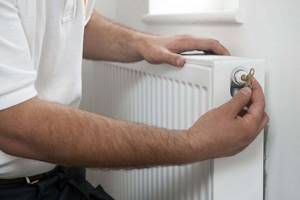
If the riser of the heating system is airy, which is understandable when cooling several radiators, you should contact service and call a plumber. If one of the radiators is airy (when the supply pipes are hot and the radiator or part of it is cold), you can bleed off the accumulated air yourself. Modern heating radiators are usually equipped with a Mayevsky tap. To bleed air, such a tap must be opened slightly until water appears. Videos and printed instructions are available on the Internet.
If there is no tap, then most likely the problem is hidden in the pipes. We recommend removing the channels with a specialized removable wrench and cleaning them from corrosive damage and other contaminants. If the pipes are no longer suitable for use, replace them with new ones.
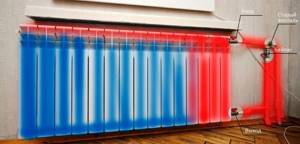
- The efficiency of heating appliances decreases.
- Reducing the room temperature.
- Adjusting additional reinforcement does not correct the situation.
Important! Do not forget that a small temperature difference between the top and bottom of the batteries is not a significant indicator of malfunction. Another thing is a significant difference in heating; it negatively affects the heating efficiency.




